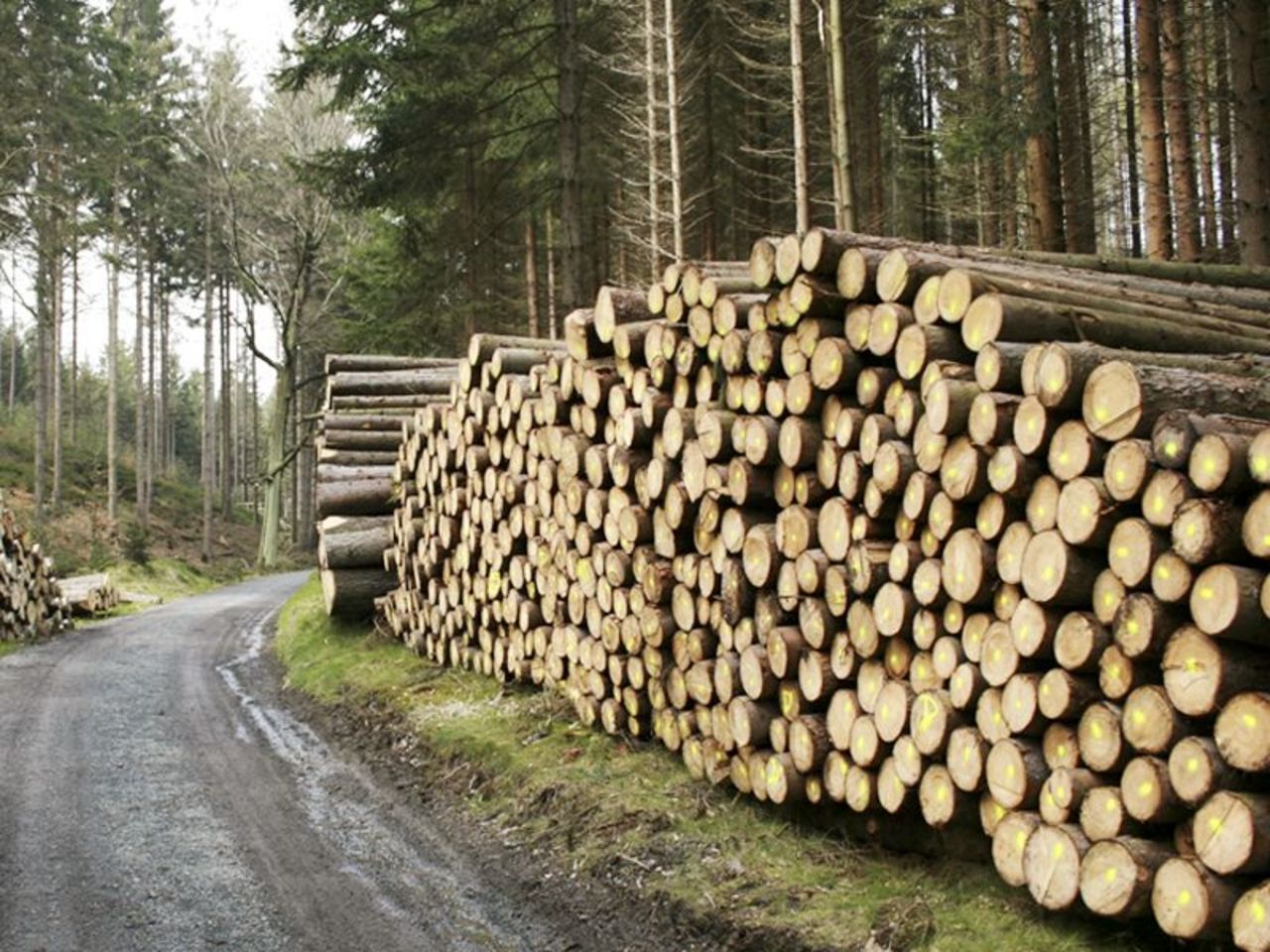Project
Analysis of the forest accountancy data network

In-depth analysis of the forest accountancy data network of the Federal Ministry for Food and Agriculture
The forest accountancy data network of the Federal Ministry for Food and Agriculture is the central data source at the federal level for assessing the economic situation of forest enterprises and for answering related policy questions. This "data treasure" will be further examined in order to gain additional insights into forest management in Germany. |
Background and Objective
In the TBN-Analysis Project the accounting results of around 350 state, municipal and private forest enterprises are collected. Forest enterprises included in the data network individually manage more than 200 hectares of forest land. Roughly 650 natural capital and business indicators are reported annually per forest enterprise on a voluntary basis.
Furthermore the TBN-Analysis Project incorporates data from the Federal Forest Inventory 2012on forest development, the wood markets and the general economic conditions. The TBN-Analysis Project analyzes in particular the evolution of the economic situation of German forest enterprises and their adaptation to changing conditions.
Target Group
Forestry practice, science and policy advice
Approach
Specific issues with high relevance for forest practice, science and policy advice are identified and through an in-depth analysis of key figures of the TBN-forest accountancy data network and their comparison with other data sets analyzed and published.
Data and Methods
Basis of the analysis are the TBN-Data from 2003 until today, with 350 state, municipal and private forest enterprises, using around 650 individual key figures. Thus, a comprehensive record of economic and natural capital data is the basis.
Results
In the scope of the project we analyzed a wide range of themes and issues with regard to the German Forest Accountancy Data Network (TBN) of the Federal Ministry for Food and Agriculture. Our main findings concerning the economic situation of German forest enterprises can be summarized as follows:
- Time series analysis using structural data of total revenues showed that the share of timber harvesting revenues of municipal and private forest enterprises between 2003 to 2013 remained steadily at around 83%. In contrast, federal state forest enterprises recorded decreasing shares from 77% to 63%.
- A study on timber harvesting data displayed a very good correlation between German National Forest Inventory 2012 data and extrapolated Forest Accountancy Network data. These findings enhance the reliability on the sampling method of Forest Accountancy Network data, fulfilling not all the requirements of representative random samples.
- A time series analysis of make-or-buy decisions of forest enterprises showed the pattern of decreasing in-house production of wood provisioning processes and increasing external procurement. Consequently, a decline in the number of employees subject to social insurance requirements could be detected. Data indicated highest shares of external procurement in private forest enterprises (all size classes) whereas municipal forest enterprises larger than 1000 ha still rely on in‑house production.
- A study on the significance of public funding on total revenues of forest enterprises displayed annual forest subsidies for Germany as a whole of about 60 Mio €/y on average in the past 12 years within the framework of the Joint Task for the »Improvement of Agrarian Structures and Coastal Protection« (GAK). Expressed in per hectare terms the annual subsidies amounted to 9.2 €/ha for private forest enterprises and to 12.4 €/ha for municipal forest enterprises above 200 ha size class on average since 2010. For federal state forest enterprises receiving funds from federal state budgets subsidies are of minor importance.
- Regional evaluations of net income per hectare, timber harvest per hectare and selling prices per cubic meter of raw wood have observed specific patterns in regional distributions of these variables. The regional distribution of net income per hectare has been demonstrated. For timber harvests per hectare South/North differences were evident. Furthermore, in Northern Germany, West/East differences were detected. For the regional distribution of selling prices South/North differences were less evident, albeit average selling prices per cubic meter in the southern federal states were highest.
- In a study to analyze influences of different economic conditions in Austria, Switzerland and Germany, key economic figures of the national forest accountancy networks were harmonized. The elaborated key figure system could also be used for economic benchmarking on forest enterprise level.
Thünen-Contact

Duration
11.2015 - 10.2016
More Information
Project status:
finished
Publikationen
- 0
Ermisch N, Franz K, Seintsch B, Englert H, Dieter M (2016) Bedeutung der Fördermittel für den Ertrag der TBN-Forstbetriebe. AFZ Der Wald 71(17):22-25
- 1
Buhrmester C, Ermisch N, Englert H (2016) Ergebnisse körperschaftlicher und privater Forstbetriebe im FWJ 2014. AFZ Der Wald 71(17):16-17
- 2
Bürgi P, Sekot W, Ermisch N, Pauli B, Möhring B, Toscani P (2016) Forstbetriebe Zentraleuropas im direkten Leistungsvergleich : ein länderübergreifender Vergleich wichtiger forstbetrieblicher Kennzahlen gibt Aufschluss über die Wettbewerbsfähigkeit der Forstbetriebe in Deutschland, Österreich und der Schweiz. AFZ Der Wald 71(17):18-21
- 3
Bürgi P, Sekot W, Ermisch N, Pauli B, Toscani P (2016) Forstbetriebe Zentraleuropas im Wettbewerbsvergleich : Betriebswirtschaftlicher Vergleich von Kennzahlen deutscher, österreichischer und schweizerischer Forstbetriebe. Holz Zentralbl 142(31):779-780
- 4
Bürgi P, Sekot W, Ermisch N, Pauli B, Toscani P (2016) Forstbetriebe Zentraleuropas unter der Lupe : ein länderübergreifender Vergleich wichtiger forstbetrieblicher Kennzahlen gibt Aufschluss über die Wettbewerbsfähigkeit der Forstbetriebe in Deutschland, Österreich und der Schweiz. Wald Holz 97(4):24-27
- 5
Bürgi P, Sekot W, Ermisch N, Pauli B, Möhring B, Toscani P (2016) Forstbetrieblicher Kennzahlenvergleich Deutschland - Österreich - Schweiz. Schweiz Z Forstwesen 167(2):73-81, DOI:10.3188/szf.2016.0073
- 6
Bürgi P, Sekot W, Ermisch N, Pauli B, Möhring B, Toscani P (2016) Les entreprises forestières d'Europe centrale examinées à la loupe : une comparaison transnationale des principaux indicateurs des entreprises forestières en Allemagne en Austriche et en Suisse fournit des renseignement sur leur compétitivité. Fôret(4):10-12
- 7
Ermisch N, Seintsch B, Englert H, Dieter M (2016) Make-or-buy-Entscheidung in der Holzaufarbeitung. AFZ Der Wald 71(17):26-29
- 8
Ermisch N, Seintsch B, Englert H, Dieter M (2016) Regionalisierte Auswertungen - TBN-Forschungsfeld mit Potenzial. AFZ Der Wald 71(17):30-34
- 9
Christoffel A, Wrede E von, Seintsch B, Ermisch N (2016) Testbetriebsnetz Forst - Teilnehmerbetriebe im Interview. AFZ Der Wald 71(17):35-36
- 10
Bauer A, Buhrmester C, Ellermann W, Englert H, Ermisch N, Gehrke A, Hübner M, Jacobs H, Jander A, Seintsch B, Trein B, Ulbricht I, Wühr F (2016) Zuständigkeiten und Organisation des TBN-Forst. AFZ Der Wald 71(17):37-40
- 11
Ermisch N, Seintsch B, Englert H (2015) Anteil des Holzertrages am Gesamtertrag der TBN-Betriebe. AFZ Der Wald 70(23):14-16
- 12
Sekot W, Toscani P, Bürgi P, Ermisch N (2015) DACH 2.0: Towards international compatibility of forest accountancy data network. In: Maric B, Avdibegovic M, Pezdevsek S (eds) IUFRO : proceedings of extended abstracts ; International IUFRO Symposium cross-sectoral policy impacts on managerial economics and accounting in forestry. Sarajevo: University of Sarajevo, pp 77-81
- 13
Ermisch N, Seintsch B, Englert H (2015) Holzeinschlag des TBN-Forst im Vergleich zur BWI. AFZ Der Wald 70(23):11-13



![[Translate to English:] Logo des Bundesministerium für Ernährung und Landwirtschaft](/media/allgemein/logos/BMEL_Logo.svg)